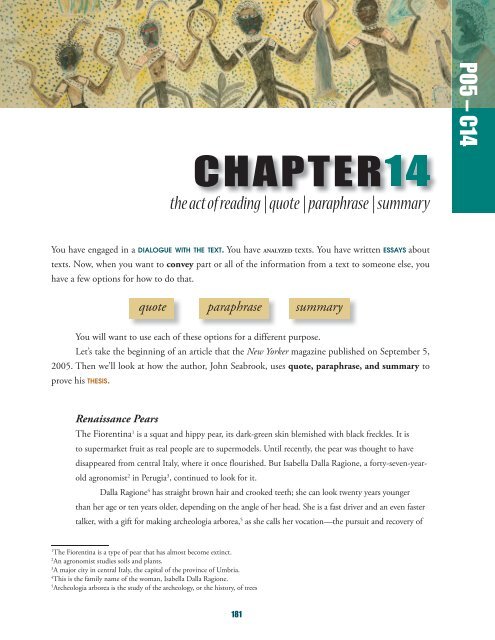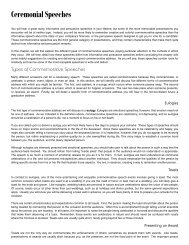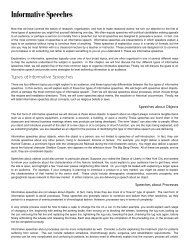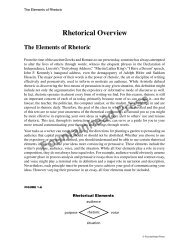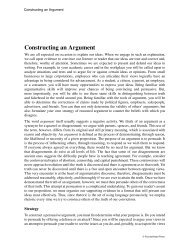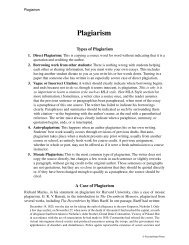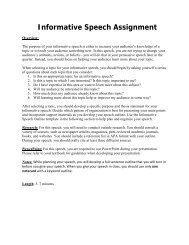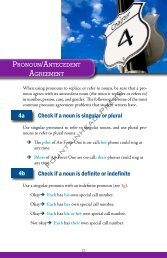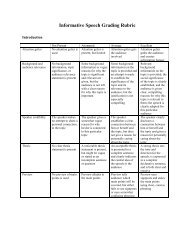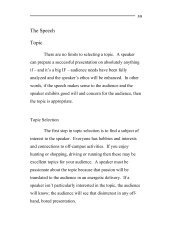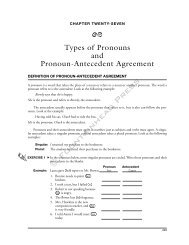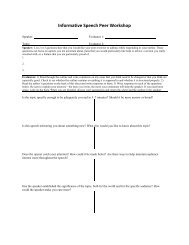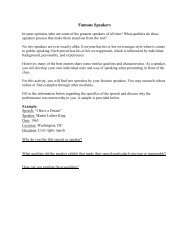Quote, Paraphrase, Summary - Fountainhead Press
Quote, Paraphrase, Summary - Fountainhead Press
Quote, Paraphrase, Summary - Fountainhead Press
You also want an ePaper? Increase the reach of your titles
YUMPU automatically turns print PDFs into web optimized ePapers that Google loves.
184 PART 5 | ORIGINS OF LANGUAGE V: Australian Mythquinces, 28 and medlars. 29 Most were common in Umbria as recently as sixty years ago; now they haveall but disappeared. Some of the Dalla Ragiones’ specimens are believed to be the last examples of thatvariety.* * *Seabrook has written about saving varieties of fruit trees threatened by extinction. In doing that,he also writes about history, art, food, culture, and how the people he encounters form their identitiesby interacting with the landscape they live in. Notice how Seabrook handles all these different subjects,how he organizes his essay to include all this interesting material, while, at the same time, he never losestouch with his THESIS.You can read the rest of this essay in the back of the book, or in the September 5, 2005 issue ofthe New Yorker, to find out what happened to Isabella Dalla Ragione and her adventures in saving theancient fruit trees of Italy.quoteWe use a QUOTE to support and prove our thesis. To QUOTE, we copy the exact words from a text,be it a written text or an oral text (someone speaking). John Seabrook QUOTES Isabella Dalla Ragione inhis essay. (We have put all the QUOTES in bold.)“Sometimes when I find one of these old trees I feel like weeping,” she said. “If only theycould talk—what a story they could tell.” Then she frowned, and said, “But I think, maybeit is better they cannot talk. They would probably curse us.”paraphraseWe may not always want to use the exact language of a text by quoting it. When we paraphraselanguage from a text, we restate that language in our own terms. A paraphrase is often about the samelength, nearly the same number of words, as the original, but rewritten in our own words.You may want to use paraphrase to vary the style of your essay. You might want to use paraphraseif a quote is too long for your essay. You might want to use paraphrase to give your reader the flavor ofyour own language or to make your reader feel that you are talking directly to him or her.28A quince is a pear-shaped fruit.29A medlar is an apple-shaped fruit.Nakell_CH14 12-17-10.indd 18412/17/10 9:40 AM
CHAPTER 14 The Act of Reading | <strong>Quote</strong> | <strong>Paraphrase</strong> | <strong>Summary</strong> 185She’s a fast driver and an even faster talker, with a gift for making archeologia arborea, as shecalls her vocation—the pursuit and recovery of old varieties of fruit—sound thrilling.summaryWhen you SUMMARIZE, you give the main points of the material from the text. A SUMMARY shouldbe much shorter than the original.You might want to use a SUMMARY:• if you give a SUMMARY of the text you’re analyzing, your reader will better understand whatyou’re talking about;• to give your reader a lot of information with a few words;• if you have a lot of information to convey to your reader, but you don’t have a lot of space todo that in;• if the original contains important information, but it does not read well or is boring;• if you have a lot of information to convey from the original, but you want your reader to hearyour voice speaking in the essay.Here, John Seabrook SUMMARIZES Isabella Dalla Ragione’s research.She finds clues in many places: Renaissance paintings, obscure books, and the recordsthat were kept by former estate owners in Umbria and Tuscany, where the climate is peculiarlyadvantageous for many kinds of fruit.Seabrook doesn’t want to go into all the detail of Isabella’s work. He wants to give the sense ofwhat she does and how she does it. He uses SUMMARY to do that.Seabrook uses all these methods—quote, paraphrase, and summary—to convey informationto us, information that, as EVIDENCE, supports his THESIS.Nakell_CH14 12-17-10.indd 18512/17/10 9:40 AM
186 PART 5 | ORIGINS OF LANGUAGE V: Australian MythChapter Review: <strong>Quote</strong>, <strong>Paraphrase</strong>, <strong>Summary</strong>We use quote, paraphrase, and summary to give our reader information fromthe material are writing about.• A quote repeats the original source language.• A paraphrase restates the original source language in your own words.• A summary conveys the main ideas of the original source.Nakell_CH14 12-17-10.indd 18612/17/10 9:40 AM


